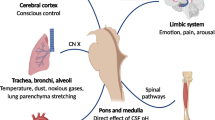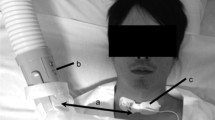Abstract
To ensure respiratory stability and flexibility, healthy breathing shows balanced variability consisting of considerable correlated variability (parameters of each breath are correlated to parameters of adjoining breaths) and some random variability. Sighing resets this balance when respiration lacks variability or becomes excessively irregular. The present study aimed to investigate the effect of imposed patterns of breathing variability on sighing and self-reported (dis)comfort. Spontaneous breathing was compared to imposed non-variable, correlated and random breathing. Results show that executing imposed breathing is difficult, demanding, and induces tension. Sigh occurrence following spontaneous and imposed breathing patterns could be predicted by self-reported discomfort and increased random variability. However, including non-variable, correlated and random breathing patterns only, the effects of self-reported discomfort on sigh occurrence override the effects of altered breathing variability.
Similar content being viewed by others
References
Abelson, J. L., Weg, J. G., Nesse, R. M., & Curtis, G. C. (2001). Persistent respiratory irregularity in patients with panic disorder. Biological Psychiatry, 49, 588–595.
Baldwin, D. N., Suki, B., Pillow, J. J., Roiha, H. L., Minnocchieri, S., & Frey, U. (2004). Effects of sighs on breathing memory and dynamics in healthy infants. Journal of Applied Physiology, 97, 1830–1839.
Bendixen, H. H., Smith, G. M., & Mead, J. (1964). Pattern of ventilation in young adults. Journal of Applied Physiology, 19, 195–198.
Benson, H. (1975). The relaxation response. NY: Morrow.
Blechert, J., Michael, T., Grossman, P., Lajtman, M., & Wilhelm, F. H. (2007). Autonomic and respiratory characteristics of posttraumatic stress disorder and panic disorder. Psychosomatic Medicine, 69, 935–943.
Bruton, A., & Thomas, M. (2011). The role of breathing training in asthma management. Current Opinions in Allergy and Clinical Immunology, 11(1), 53–57.
Caro, C. G., Butler, J., & Dubois, A. B. (1960). Some effects of restriction of chest cage expansion on pulmonary function in man: an experimental study. Journal of Clinical Investigation, 39, 573–583.
Cherniack, N. S., Euler, C., Glowgowska, M., & Homma, I. (1981). Characteristics and rate of occurrence of spontaneous and provoked augmented breaths. Acta Physiologica Scandinavica, 111, 349–360.
Conrad, A., Muller, A., Doberenz, S., Kim, S., Meuret, A. E., Wollburg, E., et al. (2007). Psychophysiological effects of breathing instructions for stress management. Applied Psychophysiology and Biofeedback, 32(2), 89–98.
Donaldson, G. C. (1992). The chaotic behaviour of resting human respiration. Respiration Physiology, 88, 313–321.
Ferris, B. G., & Pollard, D. S. (1960). Effect of deep and quiet breathing on pulmonary compliance in man. Journal of Clinical Investigation, 39, 143–149.
Finesinger, J. E. (1944). The effect of pleasant and unpleasant ideas on the respiratory pattern (spirogram) in psychoneurotic patients. American Journal of Psychiatry, 100, 659–667.
Gavish, B. (2010). Device-guided breathing in the home setting: Technology, performance and clinical outcomes. Biological Psychology, 84, 150–156.
Hirose, S. (2000). Restlessness or respiration as a manifestation of akathisia: Five case reports of respiratory akathisia. Journal of Clinical Psychiatry, 61(10), 737–741.
Hughson, R. L., Yamamoto, Y., & Fortrat, J. O. (1995). Is the pattern of breathing at rest chaotic? A test of Lyapunov exponent. Advances in Experimental Medicine and.
Kabat-Zin, J. (1990). Full catastrophe living: using wisdom of your body and mind to face stress, pain, and illness. NY: Dell Publishing.
Lehrer, P. M., Vaschillo, E., Vaschillo, B., Lu, S.-E., Eckberg, D. L., Edelberg, R., et al. (2003). Heart rate variability biofeedback increases baroreflex gain and peak expiratory flow. Psychosomatic Medicine, 65, 796–805.
Lehrer, P. M., Vaschillo, E., Vaschillo, B., Lu, S.-E., Scardella, A., Siddique, M., et al. (2004). Biofeedback treatment for asthma. Chest, 126, 352–361.
Leuner, H. (1984). Indications and scientific basis of respiratory feedback. General Practitioner, 6, 344–354.
McClernon, F. J., Westman, E. C., & Rose, J. E. (2004). The effects of controlled deep breathing on smoking withdrawal symptoms in dependent smokers. Addictive Behaviors, 29, 765–772.
McIlroy, M. B., Butler, J., & Finley, T. N. (1962). Effects of chest compression on reflex ventilatory drive and pulmonary function. Journal of Applied Physiology, 17(4), 701–705.
Mead, J., & Collier, C. (1959). Relation of volume history of lungs to respiratory mechanics in anesthetized dogs. Journal of Applied Physiology, 14, 669–678.
Meuret, A. E., Wilhelm, F. H., Ritz, T., & Roth, W. T. (2008). Feedback of end-tidal pCO2 as a therapeutic approach for panic disorder. Journal of Psychiatric Research, 42, 560–568.
Parati, G., Malfatto, G., Boarin, S., Branzi, G., Caldara, G., Giglio, A., et al. (2008). Device-guided paced breathing in the home setting: effects on exercise capacity, pulmonary and ventricular function in patients with chronic heart failure: a pilot study. Circulation Heart Failure, 1(3), 178–183.
Pelosi, P., Bottino, N., Chiumello, D., Caironi, P., Panigada, M., Gamberoni, C., et al. (2003). Sigh in supine and prone position during acute respiratory distress syndrome. American Journal of Respiratory Critical Care Medicine, 167, 521–527.
Pelosi, P., Cadringher, P., Bottino, N., Panigada, M., Carrieri, F., Riva, E., et al. (1999). Sigh in acute respiratory distress syndrome. American Journal of Respiratory Critical Care Medicine, 159, 872–880.
Reynolds, L. B. (1962). Characteristics of an inspiration-augmenting reflex in anesthetized cats. Journal of Applied Physiology, 17, 683–688.
Russel, P. (2002). The TM technique. Las Vegas: Elf Rock Publications.
Small, M., Judd, K., Lowe, M., & Stick, S. (1999). Is breathing in infants chaotic? Dimension estimates for respiratory patterns during quiet sleep. Journal of Applied Physiology, 86, 359–376.
Soltysik, S., & Jelen, P. (2005). In rats, sighs correlate with relief. Physiology & Behavior, 85(5), 589–602.
Spruyt, A., Clarysse, J., Vansteenwegen, D., Baeyens, F., & Hermans, D. (2010). Affect 4.0: A free software package for implementing psychological and psychophysiological experiments. Experimental Psychology, 57, 36–45.
Stevenson, I., & Ripley, H. S. (1952). Variations in respiration and in respiratory symptoms during changes in emotion. Psychosomatic Medicine, 14, 476–490.
Terai, K., & Umezawa, A. (2004). Effects of respiratory self-control on psychophysiological relaxation using biofeedback involving the partial pressure of end-tidal carbon dioxide. Japanese Society of Biofeedback Research, 30, 31–37.
Thayer, J. F., & Lane, R. D. (2000). A model of neurovisceral integration in emotion regulation and dysregulation. Journal of Affective Disorders, 61, 201–216.
Tobin, M. J., Chadha, T. S., Jenouri, G., Birch, S. J., Gazeroglu, H. B., & Sackner, M. A. (1983). Breathing patterns. 2 Diseased subjects. Chest, 84, 286–294.
Tobin, M. J., Yang, K. L., Jubran, A., & Lodato, R. F. (1995). Interrelationship of breath components in neighboring breaths of normal eupneic subjects. American Journal of Respiratory Critical Care Medicine, 152, 1967–1976.
Van Dixhoorn, J. (2007). Whole-Body breathing: a systems perspective on respiratory retraining. In P. M. Lehrer, R. L. Woolfolk, & W. E. Sime (Eds.), Principles and practice of stress management (pp. 291–332). New York: Guilford Press.
Vlemincx, E., Taelman, J., De Peuter, S., Van Diest, I., & Van den Bergh, O. (2011). Sigh rate and respiratory variability during mental load and sustained attention. Psychophysiology, 84(1), 117–120.
Vlemincx, E., Taelman, J., Van Diest, I., & Van den Bergh, O. (2010a). Take a deep breath: The relief effect of spontaneous and instructed sighs. Physiology & Behavior, 101, 67–73.
Vlemincx, E., Van Diest, I., De Peuter, S., Bresseleers, J., Bogaerts, K., Fannes, S., et al. (2009). Why do you sigh? Sigh rate during induced stress and relief. Psychophysiology, 46, 1005–1013.
Vlemincx, E., Van Diest, I., Lehrer, P. M., Aubert, A. E., & Van den Bergh, O. (2010b). Respiratory variability preceding and following sighs: A resetter hypothesis. Biological Psychology, 84, 82–87.
Wilhelm, F. H., Trabert, W., & Roth, W. T. (2001a). Characteristics of sighing in panic disorder. Biological Psychiatry, 49, 606–614.
Wilhelm, F. H., Trabert, W., & Roth, W. T. (2001b). Physiologic instability in panic disorder and generalized anxiety disorder. Biological Psychiatry, 49, 596–605.
Wysocki, M., Fiamma, M.-N., Straus, C., Poon, C.-S., & Similowski, T. (2006). Chaotic dynamics of resting ventilatory flow in humans assessed through noise titration. Respiratory Physiology & Neurobiology, 153, 54–65.
Acknowledgments
Elke Vlemincx is a Postdoctoral Fellow of the Research Foundation - Flanders (FWO).
Author information
Authors and Affiliations
Corresponding author
Rights and permissions
About this article
Cite this article
Vlemincx, E., Van Diest, I. & Van den Bergh, O. Imposing Respiratory Variability Patterns. Appl Psychophysiol Biofeedback 37, 153–160 (2012). https://doi.org/10.1007/s10484-012-9187-0
Published:
Issue Date:
DOI: https://doi.org/10.1007/s10484-012-9187-0




